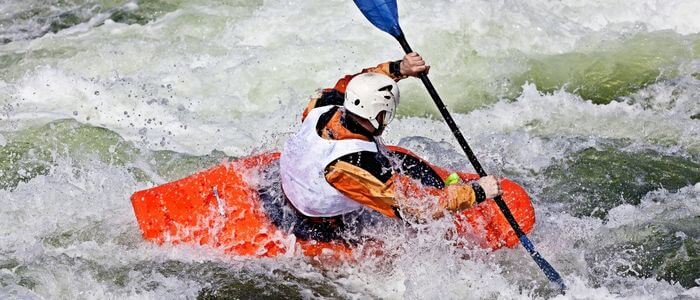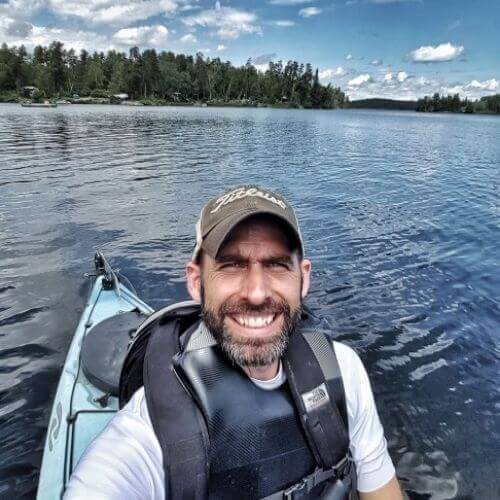
Paddling a kayak is a great way to experience nature and engage in physical activity. High winds can create waves, chops, or swells, making navigating your kayak difficult or even putting you at risk of capsizing.
But before you jump in your kayak, you must know how much wind is too much for kayaking. Wind can hugely impact your kayak journey, from making it difficult to stay on course to creating hazardous conditions on the water. Knowing when the wind is manageable is essential to have a safe kayaking experience.
With this in mind, we’ve put together a helpful guide to understanding kayaking wind speeds. We’ll go over signs of excessive wind and what you should do if you are in a situation with too much wind.

When it comes to kayaking, most people need to realize there is a maximum wind speed you should not exceed. Kayaking in too much wind can be a real safety hazard and can cause unnecessary strain on your boat and body.
So how much wind is too much for kayaking in? Generally, winds over 25 mph (or 22 knots) are considered unsafe for kayaking.
Additionally, high-speed winds can easily take you outside of the safety zone, where you won’t have any help if something goes wrong.
Ultimately, kayakers should always pay attention to their local weather conditions before going on the water.
Recreational kayaking is one of the most popular outdoor activities. It is an enjoyable way to spend time with friends or family while exploring nature. However, it is also important to understand the potential risks associated with the sport. Wind limits are key when planning a kayaking trip, as the wind can be safe and dangerous.
Considering the wind limits for recreational kayaking, it is possible to enjoy the sport safely. Through proper planning and preparation, kayakers can ensure their enjoyable and safe experience. With the right knowledge and equipment, recreational kayaking can be fun and rewarding.
Recreational kayaking is a thrilling and rewarding activity for paddlers of all skill levels. While it is an enjoyable adventure, it is important to remember that weather conditions can drastically change the experience. The wind is an often overlooked factor that can make or break a successful kayaking experience.
The safe wind limit for recreational kayaking depends on the type of kayak and the paddler’s skill. Generally, kayakers should avoid sustained winds of more than 19 mph and wind directions that are not directly behind the paddler.
In addition, experienced kayakers will typically choose to stay off the water in winds of more than 19 mph.
When paddling in windy conditions, it is important to keep an eye on the forecast and watch for any sudden changes in the wind. It is also a good idea to carry a good set of paddles, and extra clothing in case conditions become unfavorable.
Kayaking is a popular recreational activity enjoyed by many due to its thrilling yet serene experience. However, regarding kayaking, there are also some dangerous factors.
Wind limits are based on the size and type of kayak, as well as the weight of the kayaker. Generally, a sea kayaker should not kayak in winds exceeding 20 mph.
It is important to research the wind limits of your particular kayak and its weight before heading out. This will ensure a safe and enjoyable kayaking experience while also avoiding the dangers of high winds. Remember, when it comes to kayaking, safety comes first.
Sea kayaking is a popular activity that people of all ages enjoy. It is a great way to explore the world’s natural wonders and experience the beauty of the outdoors.
However, sea kayaking can also be dangerous if safety precautions are not taken and wind limits are not adhered to. Safe and dangerous wind limits for sea kayaking vary depending on the paddler’s skill level, the type of kayak, and the sea conditions.
A sea kayak is a type of boat designed for use in the open ocean and typically propelled by the paddler with a double-bladed paddle. It is an activity requiring skill and knowledge to be done safely and successfully.
Understanding the safe wind limits for sea kayaking is essential to ensure your safety while on the water.
The recommended safe wind limits for sea kayakers will not go out in winds greater than 8-10 mph. This is considered the upper limit of safe wind speed for sea kayaking. The recommended wind speed limit for novice and intermediate paddlers is upto 12 mph.
The wind speed can also be affected by the type of kayak being used, with wider, more stable kayaks able to handle higher winds than narrower, less stable kayaks. Experienced kayakers may even choose to use a sea anchor to help make their kayak more stable in high winds.
In addition to the wind speed, the wind’s direction must also be considered when sea kayaking. The wind can cause the waves to become choppier the closer they are to the source of the wind. This can make paddling difficult and create dangerous conditions if the paddler is not experienced.
Sea kayaking is a beautiful and often tranquil sport, but it can also be dangerous under certain conditions. Wind speed is one key factor when deciding if sea kayaking is safe. The wind can cause hazardous and unpredictable conditions on the water, so checking the wind limits for kayaking is essential before venturing out.
Generally, 19-24 mph wind speeds are considered too dangerous for sea kayaking, and you should avoid any wind speed above 19 altogether.
Strong winds can create treacherous swells and waves on the water, making kayaking difficult and dangerous. High winds can also make navigating difficult, as they can blow kayaks off course with surprising force.
The wind can also carry debris, including tree branches and other objects, which can cause damage to kayaks and injury to kayakers. In extreme cases, high winds can capsize a kayak, leading to a potentially life-threatening situation.
For these reasons, it is important to check the wind speed before sea kayaking. If the wind speed is above the recommended limits, staying ashore and exploring other water-based activities is best. Knowing the wind limits for kayaking can help ensure a safe and enjoyable experience.
Whitewater kayaking can be an exciting, challenging, and even dangerous pastime. The amount of wind deemed safe for kayaking can often determine the success of a kayaking adventure.
The threshold for safe wind conditions for whitewater kayaking varies from person to person and depends on the activity undertaken.
Kayaking in strong and gusty winds can be very dangerous, and kayakers must follow safe wind limits to maintain safety. Knowing how much wind is too much for kayaking is essential for any kayaker. Wind can quickly increase the difficulty of a river and put kayakers at risk of capsizing or colliding with obstacles.
For novice kayakers, a wind greater than 15 mph is generally considered safe. Whitewater kayaking in higher winds can cause the boat to become unstable, making it difficult to maneuver.
Experienced kayakers can handle higher wind speeds, depending on the conditions and the type of boat. For example, a sit-on-top kayak is more stable than a sit-in kayak in high winds, making it possible for experienced kayakers to safely handle winds up to 20 mph.
Whitewater kayaking is an exciting and thrilling outdoor water sport. However, it is important to know dangerous wind limits before taking to the rapids. Wind can affect the river’s flow, making it unstable and challenging to navigate.
It can also create waves and unexpected currents, which can cause kayaks to capsize. Therefore, it is important to understand how much wind is too much for kayaking.
Wind speed is measured in knots, with one knot equivalent to one nautical mile per hour. Generally, winds of up to 10 mph are considered safe for kayaking, but beyond this, kayakers should be aware of turbulent conditions which can make paddling difficult.
Winds of 25 mph more can lead to choppy water, waves, and strong currents, making kayaking dangerous. As wind speed increases, the danger level increases dramatically, and you should refrain from attempting kayaking in winds of 25 mph or more.
Kayak fishing is a fantastic way to enjoy the outdoors but it can also be dangerous if the winds become too strong. The question of how much wind is too much for kayaking is one that many anglers face, and the answer is only sometimes clear.
While there is no hard and fast rule for how much wind is too much for kayaking, certain wind limits are considered safe and dangerous.
Kayak fishing is a wonderful activity for those who want to get out on the water and relax. However, kayaking in windy conditions can be dangerous and difficult, so it is important to know how much wind is too much for kayaking.
Generally, wind speeds upto4-9 mph are safe for most types of kayaking, but certain conditions can make it unsafe to kayak in higher winds.
Kayaking can be a great way to spend time outdoors and explore nature. However, wind can quickly turn a peaceful day on the water into a dangerous situation.
Wind speeds above 9 miles per hour can create hazardous conditions for kayakers, making landfall the best option.
The main issue with high kayaking winds is that they can easily push you off course or even capsize your boat. This can cause you to lose valuable gear or, worse yet, put yourself at risk due to being stuck out in open waters during inclement weather.
Strong winds make paddling difficult or impossible, leading to a much slower journey back to shore than planned.
Kayak anglers need to pay close attention to wind forecasts and track the speed of nearby gusts when out on the water.
Getting out on the open water is a fantastic experience. But no matter what kind of boating you’re doing, there are a few pieces of gear you should always bring. Here are some of the most important gear you should always bring:
In conclusion, wind speed can greatly impact a kayaking experience. Although the wind can provide a calming, tranquil atmosphere to enjoy the outdoors, too much wind can be hazardous. It’s essential to keep an eye on the wind speed and ensure it is within what you can safely manage. Knowing your limits and wind speed can help you enjoy an enjoyable, safe kayaking experience.

Hey there kayak lovers! I’m Jay Schwartz, the author here at Kayak Guidance! You know water sports – you know me! My life is all about it. Kayaking, Paddleboarding, Fishing, Snorkeling and so much more. I love to share my passion and knowledge with all of you.

Hey there kayak lovers! I’m Jay Schwartz, the author here at Kayak Guidance! You know water sports – you know me! My life is all about it. Kayaking, Paddleboarding, Fishing, Snorkeling and so much more. I love to share my passion and knowledge with all of you.

Welcome to KayakGuidance.com! If you’re looking to have some fun outdoor water adventures, then you have come to the right place. We help our readers find the best kayaks and water related equipment to help you have the best time of your life whenever you are engaging in water activities.
This site is a participant in the Amazon services LLC associates program, an affiliate advertising program designed to provide a means for sites to earn advertising fees by advertising and linking to Amazon.com.